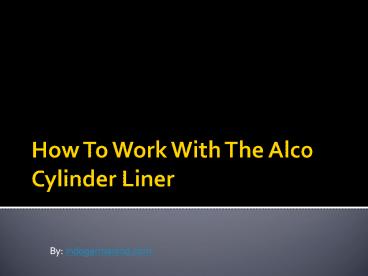How To Work With The Alco Cylinder Liner - PowerPoint PPT Presentation
Title:
How To Work With The Alco Cylinder Liner
Description:
the electric train that stretches out upwards to gather flow from the overhead lines. – PowerPoint PPT presentation
Number of Views:15
Title: How To Work With The Alco Cylinder Liner
1
How To Work With The Alco Cylinder Liner
- By indogermanind.com
2
- Wheel Arrangement Specifies what number of
wheels are available on what number of intruders
of a train. The most well-known WA today is three
wheels on either side on two intruders (3 axles),
12 wheels altogether and all axles controlled,
signified Co-Co. This is utilized in trains which
take substantial burdens, which is 80 of all in
India.
3
4
- Two intruders with two wheels on either side and
8 wheels in all out all fueled is signified by
Bo-Bo, which is useful for light, fast loads. The
WAP5 is the main major Bo-Bo train in India. - Driving Cab The "Cockpit" of the train, where
the loco pilot (driver) and collaborator and some
other sit and drive the loco. All controls and so
on are situated here.
5
- The group containing the controls to drive the
train is known as a "Control Stand". - Pantograph The arm-like gadget on the highest
point of the electric train that stretches out
upwards to gather flow from the overhead lines.
More often than not there are two of them for a
train, just one will be utilized at once.
6
7
- Shell The lodging body of the train. A WAG7 in
a WAP4 shell implies a WAG7 hardware housed in
the body that is generally utilized for the WAP4.
In Diesel trains, the shell is likewise called
the "Hood".
8
- Transmission The medium used to send the power
created by the diesel motor to the wheels. In
present day trains, the diesel motor produces
electric (AC) flow used to control footing
engines which turn the wheels. Subsequently
transmission is AC. Endlessly not the same as the
conventional car sense.
9
- Footing Motors Electric engines that "really"
drive the wheels of the train and consequently
the train. These engines are legitimately
associated with axles of the train, typically one
for each pivot. They utilize the electric power
created by the generator/alternator kept running
by the diesel motor or from the transformers
(electric locos) to yield mechanical capacity to
turn the haggles the train forward.
10
11
- ALCO American Locomotive Corporation, Inc. A
recent American producer of Diesel trains. ALCO
provided India's initially mainline Diesel
Locomotive the WDM1 and later the WDM2, which
turned into the pillar of the Indian Railways.
Every Indian train aside from the WDP/G4 depend
on the WDM2 and are classified "ALCOs"
12
- EMD Electro Motive Diesel, an American
organization which fabricates Diesel trains and
is entirely claimed by Caterpillar Inc. It was
recently possessed by GM (General Motors). EMD
provided the WDP4 and WDG4.
13
- Long Hood Forward This is a driving mode for
trains when the train is driven with the driving
taxi behind the more Hood length of the train
body. Perceivability may be an issue here and
numerous trains have speed controls when driven
in LHF. Some like the WDP4 EMDs have been
reprimanded for a really long time hoods
darkening perceivability.
14
- Short Hood Forward This driving style is
something contrary to LHF where the train is
driven with the lodge towards the front of the
train, behind the shorter "nose" of the loco.
This is really the "forward" working position of
the train, since the long hood is in fact the
back of the loco with the radiator, fumes what
not. Double Cab trains don't have LHF/SHF.
15
Train Driving Structure Design
- There are three sorts of train driving structures
in India Single Cab forward, Dual Cab forward
and Hood Unit Cab. The Dual Cab Forward sort will
have taxis or driving lodges at either end of the
train confronting outwards and is found in all
electric and more current diesel trains.
16
- This sort is the most helpful and most secure to
work as it gives the best view for the Loco
Pilots (drivers) of the route ahead and does not
require "turning" trains around. - The Single Cab Forward sort will have a driving
taxi at just one end of the train as observed in
WDP4 and WDG4 EMD trains. This plan is proposed
either to be utilized with turntables where
17
Thank you
- Created by indogermanind.com































